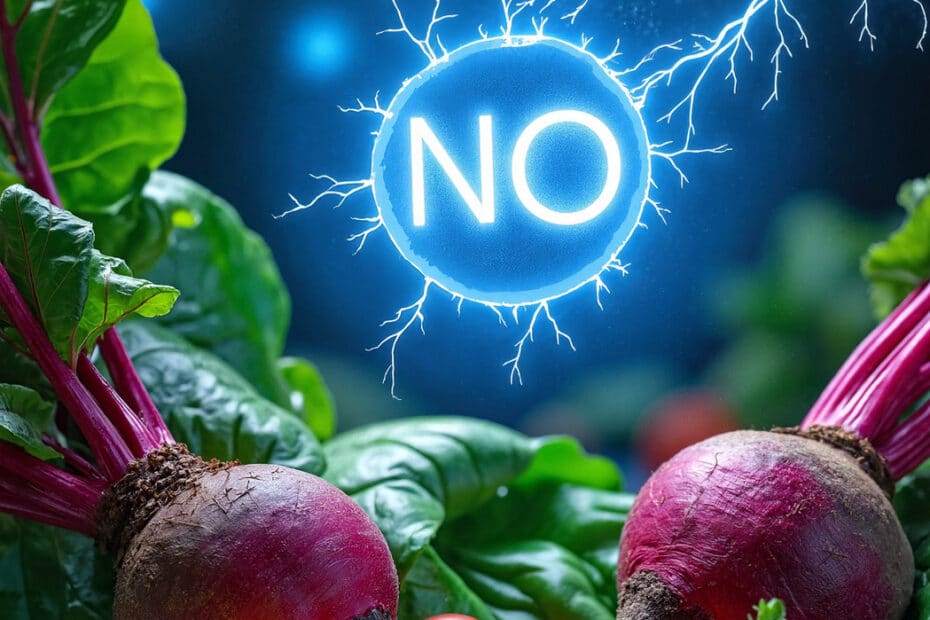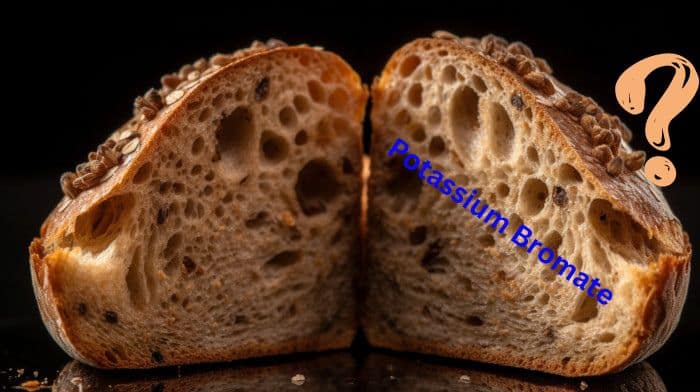Last Updated on September 4, 2025 by Max
Introduction
Have you ever wondered why certain foods, like beets or spinach, promise better health, more energy, or even improved sexual performance? The answer lies in a powerful yet often overlooked molecule: nitric oxide (NO). Recognized with a Nobel Prize in Medicine in 1998, nitric oxide is a tiny gas molecule with extraordinary potential to transform your health (Ignarro, L.J., 1998).
Nitric oxide naturally boosts circulation, enhances cellular health, and strengthens your metabolism. Whether your goal is preventing diabetes, overcoming erectile dysfunction, or improving prostate health, nitric oxide holds powerful answers supported by modern science.
Despite its impressive track record, nitric oxide remains unknown to most people outside medical or athletic communities. Fortunately, boosting your nitric oxide levels naturally through simple dietary and lifestyle changes is surprisingly easy. Imagine feeling more energized, improving cardiovascular function, and even decreasing your cancer risk, all by harnessing a molecule your body already produces.
In this article, you’ll discover how nitric oxide works, its essential health benefits backed by science, and practical tips for safely increasing your NO levels today.
The Story of Nitric Oxide: Tiny Molecule, Massive Impact
Nitric oxide (NO) may sound complicated, but understanding its role in your health is simple. It is a small gas molecule composed of just two atoms: nitrogen and oxygen (chemical formula: NO). Despite its modest appearance, nitric oxide holds extraordinary power to transform how your body functions—from your blood vessels to your immune system.
Interestingly, nitric oxide wasn’t always recognized as beneficial. Until the late 1980s, scientists considered it primarily a pollutant, produced mainly by vehicle exhaust and industrial processes. But in a discovery that earned a Nobel Prize in Medicine, three researchers—Robert Furchgott, Louis Ignarro, and Ferid Murad—proved otherwise. They demonstrated that nitric oxide acts as a powerful signaling molecule, relaxing blood vessels and enhancing circulation throughout the body (Furchgott, R.F., 1998).
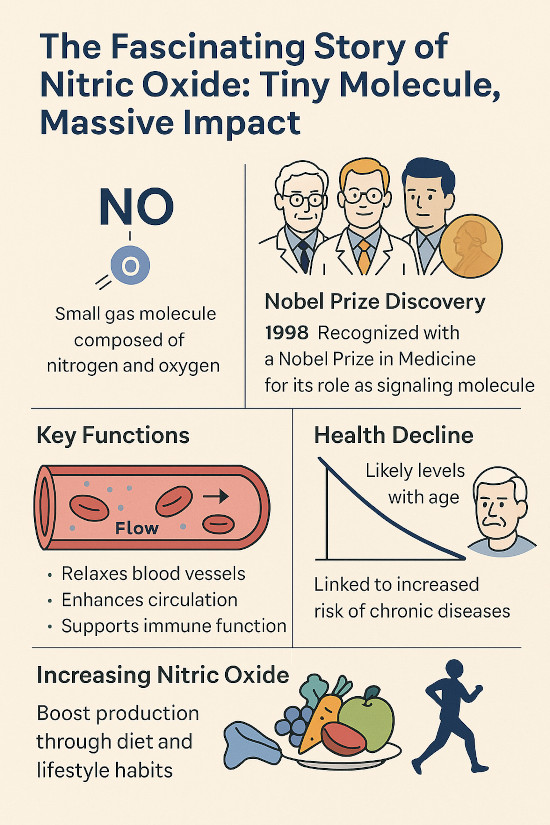
This revolutionary finding revealed nitric oxide as one of your body’s most important molecules for maintaining vascular health, regulating blood pressure, and promoting optimal circulation. It directly signals the smooth muscle cells in blood vessels to relax, allowing blood to flow more freely. Improved blood flow supports not just heart health but also sexual performance, brain function, prostate wellness, and even immunity.
Yet, nitric oxide levels naturally decline as you age, contributing to increased risks of hypertension, metabolic issues, erectile dysfunction, and other chronic diseases (Moncada, S., 2006). The good news is, you can take control. By harnessing simple dietary and lifestyle habits, you easily stimulate your body’s nitric oxide production, paving the way to healthier, more vibrant living.
In the next sections, we’ll explore how nitric oxide works inside your body and share effective strategies to increase your levels naturally.
How Your Body Makes Nitric Oxide: The Two Natural Pathways
There are two primary pathways your body uses to generate nitric oxide: one relies on amino acids and enzymes, and the other uses nitrate-rich foods and your gut bacteria. Both systems are powerful, and both respond directly to your diet and lifestyle—giving you real control over how much nitric oxide you produce.
1. The Arginine-NOS Pathway: Enzymatic and Fast-Acting. In this pathway, your body converts the amino acid L-arginine into nitric oxide through the action of an enzyme called nitric oxide synthase (NOS). This process happens quickly and locally in tissues like blood vessels, nerves, and immune cells. There are three forms of the NOS enzyme, each with different jobs:
- eNOS (endothelial NOS): found in blood vessels, crucial for controlling blood pressure and flow
- nNOS (neuronal NOS): found in nerve tissue, important for brain signaling and muscle control
- iNOS (inducible NOS): produced by immune cells during inflammation to fight infections
When NOS enzymes are active, they break down L-arginine to produce NO and citrulline, creating a localized burst of nitric oxide where it’s needed most. This pathway is especially important for: 1. Relaxing blood vessels, 2. Enhancing exercise performance, 3. Supporting sexual function, and 4. Regulating insulin sensitivity. However, this system relies heavily on good blood vessel health, the presence of cofactors like BH4, and sufficient oxygen—all of which decline with age and poor lifestyle choices.
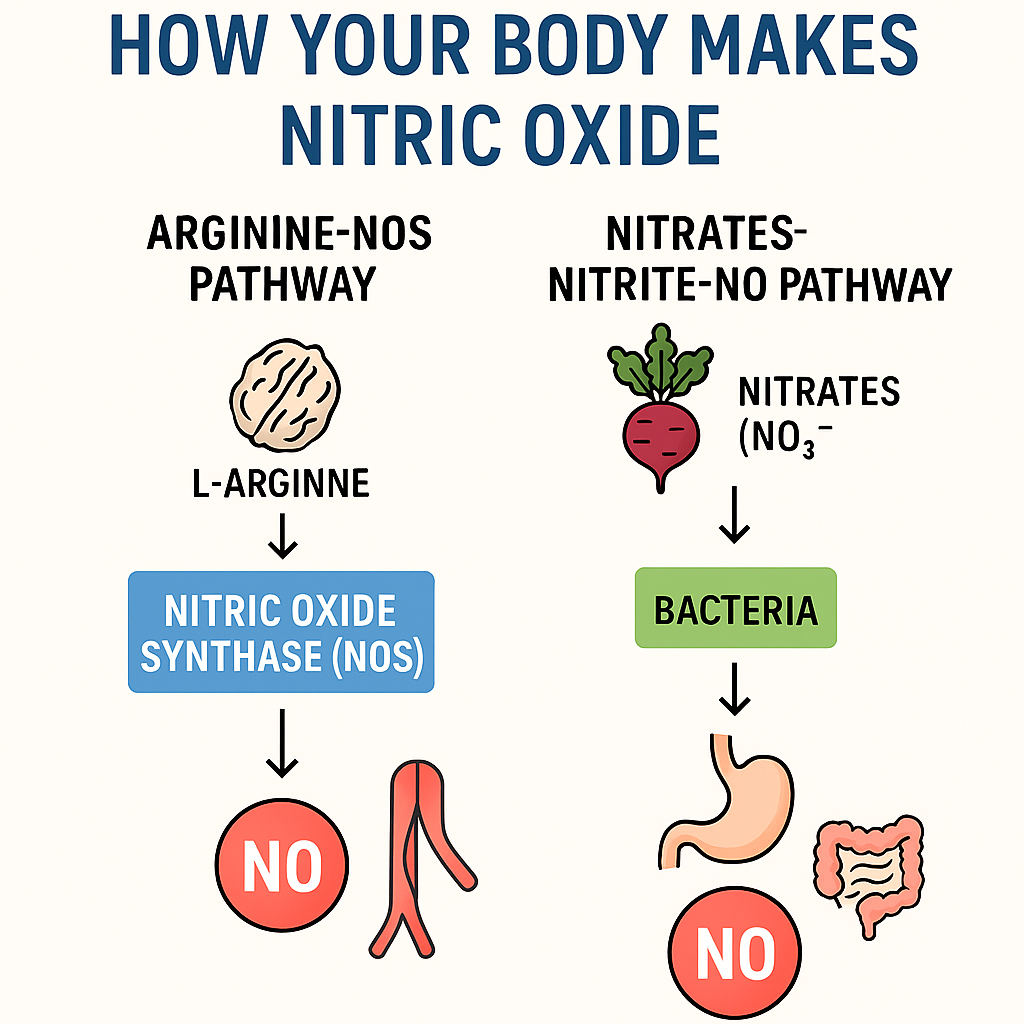
2. The Nitrate-Nitrite-NO Pathway. This second, lesser-known pathway starts with the nitrates in your food—especially vegetables like beets, spinach, arugula, and celery. Once you eat nitrate-rich foods, here’s what happens: Nitrates (NO₃⁻) are absorbed in your saliva and gut. Oral bacteria on your tongue convert them into nitrites (NO₂⁻). In your stomach and bloodstream, nitrites are further reduced to nitric oxide (NO)—especially under low oxygen conditions, like during intense exercise.
Unlike the arginine pathway, this route doesn’t require enzymes or oxygen, making it particularly useful when blood flow is compromised—such as in aging, heart disease, or metabolic dysfunction (Lundberg, J.O., 2008). This is why nitrate-rich diets show such dramatic results in lowering blood pressure, improving athletic performance, and enhancing blood flow even in individuals with vascular disease.
Why These Pathways Matter to Your Health. Both of these systems work together to maintain optimal nitric oxide levels. When one pathway is compromised—due to age, chronic inflammation, or metabolic disorders—the other can compensate. That’s why combining arginine-rich foods (like nuts and turkey) with nitrate-rich vegetables (like beets and leafy greens) creates a robust foundation for nitric oxide production. Studies show that supporting both pathways leads to improved blood flow, reduced insulin resistance, and even better outcomes in erectile function and cardiovascular health (Kapil, V., 2015).
Nitric Oxide’s Mechanisms of Action
Once produced, nitric oxide doesn’t just sit idle—it acts immediately and locally, sending signals to nearby cells and tissues to maintain homeostasis. In this section, we’ll break down the three key mechanisms by which nitric oxide drives healing, circulation, immunity, and cellular resilience.
Vasodilation in Action: Slide to release NO
1. Vasodilation: Opening the Highways of Your Circulatory System. Nitric oxide’s most famous role is relaxing and widening your blood vessels, a process known as vasodilation. Here’s how it works. When NO is released by the endothelial cells lining your arteries, it quickly penetrates the adjacent smooth muscle cells. There, it activates an enzyme called guanylate cyclase, which increases levels of cyclic GMP (cGMP). This chemical cascade causes the muscles to relax, expanding the vessel diameter and increasing blood flow (Ignarro, L.J., 2002).
This vasodilatory effect lowers blood pressure, improves oxygen delivery, boosts nutrient transport to muscles, the brain, the heart, and even reproductive organs, and enhances erectile function, athletic performance, and brain clarity. In people with hypertension or atherosclerosis, NO production is often impaired, causing chronic constriction of blood vessels and reduced oxygenation of tissues. That’s why supporting NO levels is key to cardiovascular protection.
2. Cellular Signaling: NO as a Messenger Molecule. Nitric oxide is a gaseous signaling molecule, which means it slips easily through cell membranes to deliver instructions. Unlike hormones or neurotransmitters that bind to receptors, NO diffuses directly into cells, activating enzymes, ion channels, and transcription factors.
What does that look like in action? In your nervous system, NO helps neurons communicate efficiently, improving focus, learning, and memory. In your immune system, NO activates macrophages and other immune cells, helping them kill pathogens and regulate inflammation. In muscle and energy metabolism, it influences mitochondrial function—supporting ATP production and reducing fatigue. Because of its free radical nature, nitric oxide acts fast—but its effects are potent and widespread.
3. Combating Inflammation and Oxidative Stress. Oxidative stress happens when harmful molecules, called reactive oxygen species (ROS), accumulate in your tissues. This is a major driver of cellular aging, inflammation, and chronic disease. Nitric oxide plays a balancing role here. When present in the right concentrations, NO:
- Neutralizes free radicals, preventing DNA and protein damage
- Reduces pro-inflammatory cytokines, dialing down chronic immune activation
- Improves endothelial integrity, preventing white blood cells from sticking to blood vessel walls
This is why low nitric oxide levels are linked to accelerated aging, endothelial dysfunction, and diseases like diabetes, arthritis, and even Alzheimer’s (Förstermann, U., 2012).
Why Good Nitric Oxide Levels Matter for Your Health
Modern lifestyles filled with processed foods, sedentary habits, chronic stress, and poor sleep habits gradually deplete your body’s nitric oxide reserves. Over time, this decline sets the stage for a range of chronic diseases. Let’s break down exactly where nitric oxide fits into the big picture of human health.
Cardiovascular Health & Blood Pressure. Nitric oxide is the body’s master regulator of vascular tone. It relaxes blood vessels, increases arterial flexibility, and promotes smooth blood flow. That means your heart doesn’t have to work as hard to pump blood through your system. Multiple studies confirm that insufficient nitric oxide production contributes to hypertension, atherosclerosis, and heart failure. For example, patients with coronary artery disease consistently show reduced endothelial nitric oxide synthase (eNOS) activity, along with higher oxidative stress and arterial stiffness (Förstermann, U., 2012).
Restoring nitric oxide through nitrate-rich foods or arginine/citrulline supplementation helps lower systolic and diastolic blood pressure by as much as 4–10 mmHg, even in people with mild hypertension (Kapil, V., 2015).
Metabolic Health: Preventing Diabetes & Insulin Resistance. Nitric oxide is essential for insulin sensitivity. It helps insulin trigger vasodilation, allowing glucose and nutrients to move efficiently into skeletal muscle cells. Low NO levels reduce this blood flow, causing glucose to accumulate in the bloodstream—a key feature of insulin resistance and type 2 diabetes.
Chronic NO deficiency has been linked to elevated fasting glucose, higher HbA1c levels, abdominal fat accumulation, and increased inflammation markers like CRP and IL-6. Improving NO status reverses many of these changes. Studies show that nitrate-rich diets enhance glucose uptake and improve insulin action, particularly in overweight or prediabetic individuals (Gilchrist, M., 2013).
Sexual Health & Erectile Function. One of nitric oxide’s most talked-about functions is its role in sexual performance, especially in men. NO is the primary signaling molecule that triggers penile erection. It relaxes the smooth muscle of the corpus cavernosum, allowing blood to fill the erectile tissue. When nitric oxide production drops—as it often does with aging, stress, or poor cardiovascular health—erections become weaker or inconsistent. This is the physiological root of erectile dysfunction (ED).
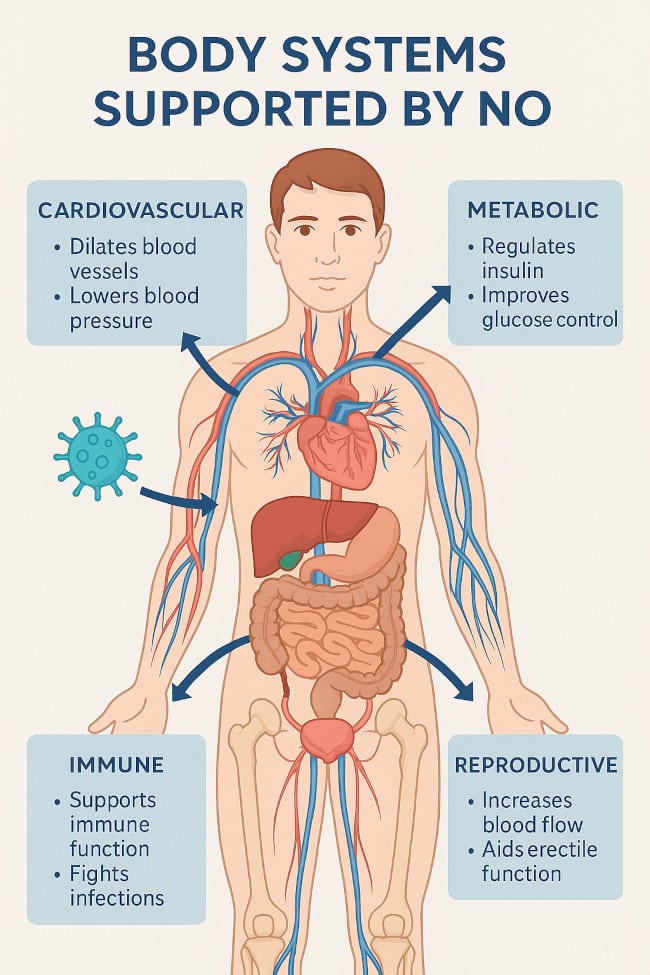
It’s no coincidence that ED medications like sildenafil (Viagra) work by enhancing the nitric oxide pathway. They prevent the breakdown of cGMP, extending the vasodilatory effect of NO. But for lasting improvement, the body still needs to make enough NO naturally—and that’s where diet, exercise, and supplementation come in.
Cancer & Chronic Disease Prevention. Nitric oxide has a dual role in cancer biology—protective in moderate levels, but potentially harmful in excess. Under healthy conditions, nitric oxide helps:
- Suppress tumor initiation
- Enhance immune surveillance
- Improve oxygenation of tissues
- Trigger apoptosis (programmed cell death) in abnormal cells
Research shows that NO modulates key enzymes and transcription factors that control cell cycle, inflammation, and DNA repair (Korde Choudhary, R., 2021). Low NO levels create an environment where damaged cells persist, inflammation rises, and the immune system weakens. Furthermore, nitric oxide reduces systemic oxidative stress and inflammation—two root causes of most chronic diseases, including Alzheimer’s, arthritis, and prostate disorders.
How to Boost Your Nitric Oxide Naturally: A Quick Start Guide
You can increase your body’s NO production naturally—without prescriptions or invasive procedures. Here’s what you can start doing today to supercharge your nitric oxide production.
1. Eat More Nitrate-Rich Foods (Your Body’s Favorite Fuel). The simplest and most powerful way to elevate nitric oxide levels is through your plate. Dietary nitrates—especially from vegetables—get converted into nitrite and then into nitric oxide by your body, fueling your circulatory and immune systems.
Nitrate Content in Common Vegetables (Values in mg of nitrate per 100 grams of fresh weight)
| Vegetable | Nitrate Content (mg/100g) | Notes |
|---|---|---|
| Arugula (Rocket) | 250–480 | Highest natural nitrate concentration; varies by season and sunlight |
| Spinach | 250–400 | Well-known NO-boosting leafy green |
| Beetroot | 110–180 | Root form is rich; beet juice is often concentrated |
| Swiss Chard | 150–250 | Both red and green varieties are high in nitrate |
| Butterhead Lettuce | 200–300 | Includes Boston and Bibb types |
| Celery | 150–250 | High in nitrate and commonly juiced for circulation support |
| Romaine Lettuce | 100–180 | Moderate nitrate content; widely available |
| Radishes | 80–120 | Good for variety in NO-friendly salads |
| Turnip Greens | 70–120 | Often overlooked source of dietary nitrate |
| Cabbage (Raw) | 45–70 | Lower nitrate but beneficial in large servings |
| Carrots | 90–110 | Especially higher in nitrate when grown in shaded soil |
Eating these regularly—even a single serving per day—can measurably lower blood pressure, increase endurance, and improve vascular function within one to two weeks.
Daily Nitric Oxide Score — adjust your habits and see the impact
2. Move Your Body (Exercise Turns On NO Production). Every time you engage in aerobic exercise, your blood vessels respond by shearing against the endothelium, which stimulates nitric oxide release. The effect is immediate and cumulative. The more you move, the more your blood vessels adapt. Best forms of NO-boosting exercise: Brisk walking (20–30 minutes a day), Cycling or swimming, Strength training (with moderate rest intervals), and High-Intensity Interval Training (HIIT), which spikes NO production sharply.
Bonus: Regular exercise also reduces oxidative stress, which helps protect existing nitric oxide from being degraded in your body.
3. Consider Natural Supplements (Backed by Science, Not Hype). Certain supplements can enhance NO production—especially when your diet or lifestyle falls short. While not a replacement for healthy habits, they can give you an extra edge. Notable NO-boosting supplements:
- L-arginine: an amino acid used in the NOS pathway
- L-citrulline: more bioavailable than arginine, sustained NO production
- Beetroot extract: concentrated dietary nitrate
- CoQ10 and Vitamin C: protect NO molecules from oxidative damage
We’ll break down the best dosages, brands, and combinations in an upcoming post. But for now, remember: a few small steps can have big health payoffs.
4. Breathe, Hum, and Protect Your Mouth Microbiome. Beyond food and exercise, your breathing patterns and oral hygiene habits play a powerful but often overlooked role in nitric oxide production. When you consume nitrate-rich foods (like beets, spinach, or arugula), nitrates are absorbed in your small intestine, and about 25% are actively re-secreted into your saliva. Here’s where it gets fascinating:
Your tongue and gums host special nitrate-reducing bacteria that convert dietary nitrates (NO₃⁻) into nitrites (NO₂⁻)—a critical step in producing nitric oxide without relying on oxygen or enzymes (Lundberg, J.O., 2008). This makes the mouth essential for NO production, especially in older adults or people with endothelial dysfunction.
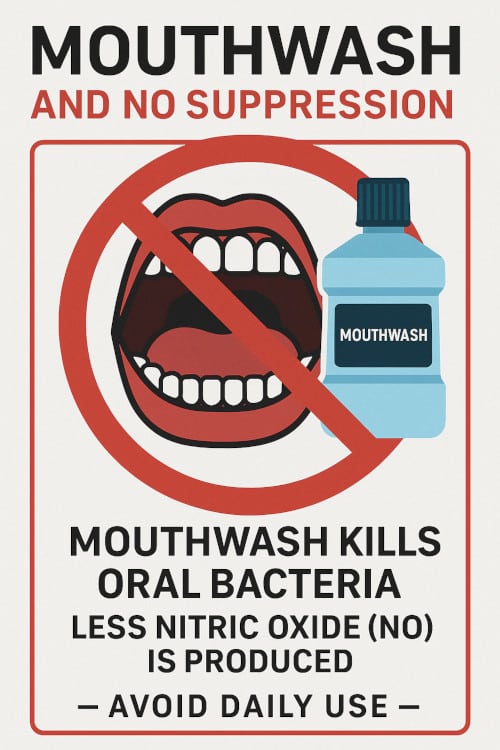
Avoid Antibacterial Mouthwash. Many commercial mouthwashes kill the good bacteria needed for this nitrate conversion. Several studies have shown that using antiseptic mouthwash reduces NO levels and can even raise blood pressure as a result (Kapil, V., 2013). Unless prescribed for a medical condition, it’s better to use natural or fluoride-only toothpaste, avoid alcohol-based rinses, and focus on flossing and tongue brushing instead.
Humming and Nasal Breathing: Surprising but Real. Did you know nasal breathing—especially while humming—can increase nitric oxide in your upper airways by up to 15-fold?. Here’s how. The nasal sinuses produce nitric oxide naturally. Breathing through your nose allows this NO to reach the lungs and bloodstream. Humming vibrates the sinus walls, increasing nitric oxide production even further (Lundberg, J.O., 1995). Incorporating simple breath practices like humming for 5–10 minutes a day or switching to nasal-only breathing during rest and exercise can enhance NO availability in both your airways and circulation.
✅ What Toothpaste to Choose?
- Fluoride-only toothpaste: These are standard toothpastes that contain fluoride (which protects against cavities) but do not contain antimicrobial agents like triclosan, chlorhexidine, or stannous fluoride that can kill beneficial oral bacteria involved in nitric oxide (NO) production.
- Natural toothpastes: These are free of harsh chemicals, alcohols, and antiseptic agents that can disrupt the oral microbiome. Many natural brands avoid SLS (sodium lauryl sulfate) and other surfactants that may harm bacterial diversity on the tongue and gums.
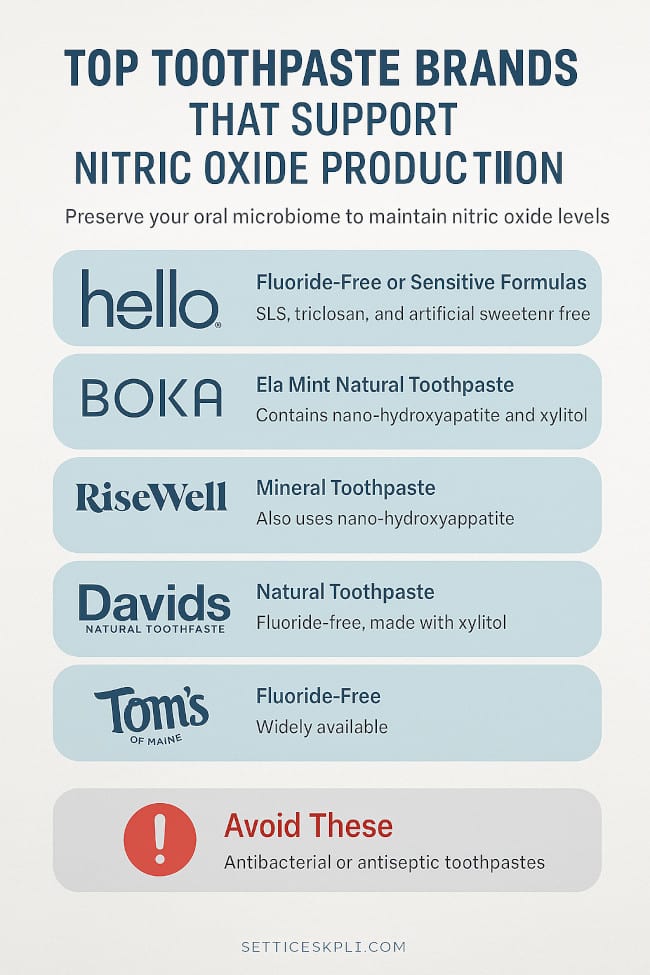
What to Avoid Daily (if NO production is your goal)? Toothpastes or mouth rinses labeled as “antibacterial”, “antiseptic,” or “gum disease-fighting” often contain agents that kill both harmful and beneficial bacteria. Common culprits include:
- Chlorhexidine
- Triclosan (now banned in many countries)
- Cetylpyridinium chloride
- Stannous fluoride (can have some antimicrobial activity)
These agents are useful in medical situations (like after surgery or in treating gingivitis), but regular, long-term use can impair the nitrate-to-nitrite conversion in your mouth, blunting one of your body’s main nitric oxide production pathways.
Avoid These If Supporting NO Is a Priority:
- Colgate Total® (contains triclosan in some versions)
- Crest Pro-Health® (may contain stannous fluoride or cetylpyridinium chloride)
- Any antibacterial or antiseptic-labeled toothpaste
Considerations: If you’re using fluoride-free toothpaste, just ensure you’re getting fluoride protection elsewhere, especially if you’re cavity-prone. Fluoride strengthens enamel and prevents decay. You can rotate between fluoride-free (for NO support) and fluoride-containing toothpaste (for enamel support) if needed. To maximize nitric oxide production, also brush your tongue gently—that’s where many of the nitrate-reducing bacteria live.
What’s Coming Next on Your Healthy Prostate
In the coming blog posts, we’ll go deeper into how nitric oxide influences specific health concerns—especially those that matter most as we age. Here’s a Sneak Peek at What’s Coming:
1. Endothelial Health Uncovered. Learn how nitric oxide protects your blood vessels from stiffness, inflammation, and plaque buildup—and how early endothelial dysfunction is a silent warning sign for cardiovascular disease. We’ll break down tests, symptoms, and solutions.
2. Metabolic Health & Blood Sugar Control. Discover nitric oxide’s powerful role in regulating insulin sensitivity, fat metabolism, and glucose delivery. You’ll learn why boosting NO may be one of the most overlooked tools in diabetes prevention.
3. Erectile Dysfunction & Male Sexual Vitality. Get the full breakdown of how nitric oxide controls arousal, blood flow, and erectile function—and why supporting your body’s NO pathway is the natural foundation for sexual performance.
4. Nitric Oxide’s Role in Cancer Defense. Explore nitric oxide’s double-edged sword in cancer biology—how it helps your immune system detect and destroy abnormal cells, but also how chronic inflammation can hijack NO for tumor growth. You’ll learn how to tilt the balance in your favor.
Subscribe NowFollow Along and Take Control
Each post in this series will provide science-backed explanations, simple lifestyle changes, and practical visuals to help you boost nitric oxide levels naturally—one system at a time.
Want to be notified when the next post drops? Make sure you’re subscribed to Your Healthy Prostate and follow us on your favorite platform. You’re not just reading about health—you’re building it, molecule by molecule.
References
Ignarro, L.J. (1998). Nitric oxide as a unique signaling molecule in the vascular system. Journal of Physiology, 20(4), 15–19. [Nobel Prize-winning research on nitric oxide’s role in cardiovascular signaling.]
Furchgott, R.F., Ignarro, L.J., & Murad, F. (1998). The Nobel Prize in Physiology or Medicine – for discoveries concerning nitric oxide as a signaling molecule in the cardiovascular system.
Moncada, S. (2006). Nitric oxide: discovery and impact on clinical medicine. Journal of the Royal Society of Medicine, 99(6), 301–307.
Lundberg, J.O., Weitzberg, E., & Gladwin, M.T. (2008). The nitrate–nitrite–nitric oxide pathway in physiology and therapeutics. Nature Reviews Drug Discovery, 7(2), 156–167.
Kapil, V., Weitzberg, E., Lundberg, J.O., & Ahluwalia, A. (2015). Clinical evidence demonstrating the utility of inorganic nitrate in cardiovascular health. Hypertension, 65(5), 956–962.
Gilchrist, M., Winyard, P.G., & Benjamin, N. (2013). Dietary nitrate – good or bad? Nitric Oxide, 26(2), 259–266.
Förstermann, U., & Sessa, W.C. (2012). Nitric oxide synthases: regulation and function. European Heart Journal, 33(7), 829–837.
Korde Choudhary, R., & Bodhankar, S.L. (2021). Nitric oxide in cancer biology: A double-edged sword. Journal of Cancer Research and Therapeutics, 17(3), 545–552.
Kapil, V., Milsom, A.B., Okorie, M. et al. (2013). Inorganic nitrate supplementation lowers blood pressure in humans: role for nitrite-derived NO. Hypertension, 61(4), 856–862.
Lundberg, J.O., & Weitzberg, E. (1995). Nasal nitric oxide in man. Thorax, 50(7), 747–748.
